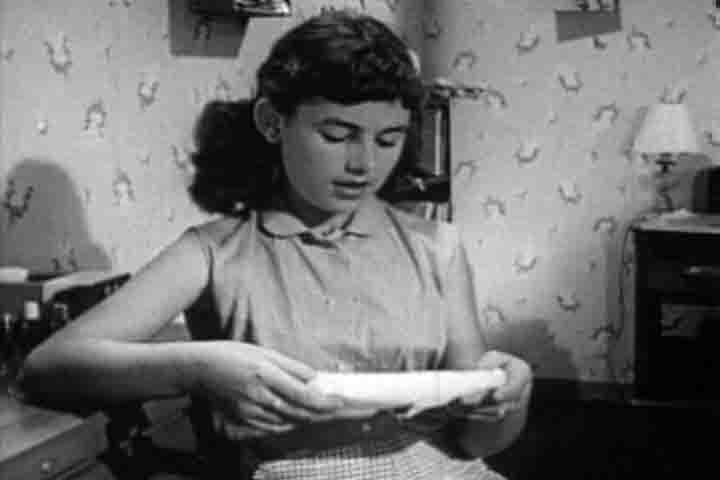
Screenshot from Molly Grows Up, 1953. Public domain.
Do you know why women menstruate? Do you know what the word menstruation means? If your primary source of sex education came from American “educational” films from the 1940s-1960s, you probably have only a vague idea about most things related to sex and puberty.
Released in 1953, the short film Molly Grows Up is one such video. While it may or may not have been designed to put young girls’ minds at ease regarding their first period, it is lacking much in the way of medical facts. Molly’s story is told by the school nurse (who also might be a family friend; the plot, like the acting and writing, leaves much to be desired), a practical woman who also conveniently substitute teaches Molly’s (all girl) class one day, allowing her to talk to all them about menstruation.
Molly is a young girl of around 13 years old, and she and her friends are all getting, or are close to getting, their periods. Molly is excited and curious about her period, and–in a distinct departure from my pubescent years–is very open about all of this with her mother, sister, friends, and the school nurse. When she gets her period, she tells her mother, who has a little “conference” with her that evening after supper. Molly’s mother tells her that her period will come every month, but doesn’t explain why when Molly asks, leading me to think that either the writers didn’t know (despite having 2 PhDs and 2 MDs amongst them), or thought the answer too complicated for the female brain. She also tells Molly that good posture will help her organs to have more room and function better (why this is only applicable now that Molly has her period, I’m unsure). The other bit of highly inaccurate advice she gives her daughter is not to swim in the first few days of her period so she doesn’t “get chilled and catch cold.” Molly’s mother does, however, point out that when Molly calls it her “curse,” she sounds old-fashioned and silly about a natural process.
The school nurse expands on some of these comments, further spreading inaccuracies, as well as giving modern viewers a glimpse into the social norms of the time. The nurse repeats the notion of not swimming in the early part of the period, but does encourage bathing or showering, and washing one’s hair–provided you use warm water and dry well so as to not get chilled! She warns against strenuous activities, such as skating, horseback riding, vigorous games like volleyball and basketball, and, oddly enough‚ square dancing (though regular dancing is fine, apparently, as that’s in her “do” column). She includes a diagram of the uterus and ovaries, and a simplistic, though not inaccurate, explanation of the menstrual cycle.
Most telling for the time, however (beyond the total lack of diversity amongst the cast, although the film was made a year before the Supreme Court’s ruling on Brown vs. the Board of Education), is the nurse’s reply to the question “can people tell when I have my period?” “No,” she says, but follows that up with suggestions as to how to “be your most attractive self.” Be more aware of personal cleanliness and daintiness. Regularly change your panties. Use deodorant. Wear your prettiest dress. In other words, be pretty and be fertile to attract a man, because menstruation is natural and normal, and it’s all “leading up to being a mother.”
Lest I imply that modern sex education in America is enlightened and fully factual, it’s not. Sexist overtones aside, Molly Grows Up is arguably less dangerous than abstinence only teaching. An example of abstinence-only teaching can be seen in this clip from The Simpsons:
There are also some truly dangerous modern sex education videos out there, which place the burden of sexual behavior on women, using slut-shaming as their tool. Others completely side-step the notion of consent. For an eye-opening view of modern sex education in America, check out John Oliver’s 2015 piece on Last Week Tonight (HBO) (note: language isn’t safe for work).
-Katie Weidmann
Social Media Manager
Girl Museum Inc.
This post is part of our 52 Objects in the History of Girlhood exhibition. Each week during 2017, we explore a historical object and its relation to girls’ history. Stay tuned to discover the incredible history of girls, and be sure to visit the complete exhibition to discover the integral role girls have played since the dawn of time.
